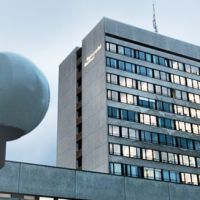An umbilical hernia is a fairly frequent form of rupture in the abdominal wall. In this, the hernial ring is located in the navel region, which is commonly a natural weak point in the abdominal wall.
Recommended specialists
Article overview
- Definition: This is an umbilical hernia
- Risk factors for the emergence of an umbilical hernia
- Symptoms and characteristics of umbilical hernias
- Diagnosis of an umbilical hernia
- Umbilical hernia treatment
- When is surgery necessary?
- Procedures and techniques for umbilical hernia surgery
- Complications and risks in umbilical hernia surgery
- Follow up treatment after umbilical hernia surgery
Umbilical hernia surgery - Further information
Definition: This is an umbilical hernia
The navel marks the spot where the embryonic umbilical cord vessels protruded outwards through the abdominal wall. As growth proceeds later, if the abdominal wall does not form completely here, a hernial ring can develop out of this weak point. If a protrusion forms in the abdominal wall and if the contents of the abdomen emerge (e.g. fatty tissue or parts of the bowel), this is called an umbilical hernia.
An umbilical hernia can occur in both boys and girls with roughly the same frequency. However, children with a dark skin coloring are affected more often than children with a white skin coloring. 98% of umbilical hernias up to the child's second year retract of their own accord and the risk of organs becoming trapped during childhood is very low, so there is generally no need (indication) of umbilical hernia surgery up to this age.
Adults can also experience umbilical hernias relatively often because of abdominal wall weakness, distension or increased pressure in the abdominal cavity. Generally, however, adults affected in this way have no discomfort.
Risk factors for the emergence of an umbilical hernia
Umbilical hernias in new-born babies are normal before the navel scar has fully formed. It is common for children, especially those with a very low birth weight, to develop an umbilical hernia. For example, two thirds of premature babies with a weight at birth of less than 1,500 g have an umbilical hernia.
In adults, all the factors behind increased pressure in the abdominal cavity represent risk factors for an umbilical hernia. For example, severe overweight, strenuous lifting, cirrhosis of the liver and ascites (fluid accumulation in the abdomen) and also pregnancy represent an increased risk.
A further risk factor for an umbilical hernia is a family disposition for weakness of the connective tissue.
Symptoms and characteristics of umbilical hernias
Although an umbilical hernia can cause discomfort, it does not necessarily do so. Initially, the umbilical hernia becomes apparent because of swelling and protrusion around the navel, which is relatively easy to press back into the abdominal cavity.
However - particularly if an infant wails intensively - it may be that the hernia will not immediately slip back into the abdominal cavity. In the course of time however, especially when standing up or just standing, the umbilical hernia can get bigger and become painful, especially when coughing, straining on the toilet or engaging in physical or sporting activities. The umbilical hernia can also remain visible when lying down and without straining.
However, if severe pain with a high temperature, nausea and vomiting is suddenly experienced and if the protrusion can no longer be pushed back or if the hernia turns blue, there is a risk of the protruding bowel becoming trapped. A life-threatening bowel obstruction may be the result. In some circumstances, parts of the bowel will not receive sufficient blood and oxygen. Then the affected area is in danger of dying, admitting bacteria into the abdominal cavity and the vascular system - all acute risks to life. In this case, immediate surgery is essential.
Diagnosis of an umbilical hernia
The soft protrusion right by the navel or of the navel itself generally leads the doctor to suspect that the patient could have an umbilical hernia. By feeling the protrusion when the patient is lying on his back, the doctor can usually get a good impression of the hernial ring. The doctor can judge whether and how easily the contents of the hernia sac can be pushed back into the abdominal cavity.
Depending on the size of the umbilical hernia and the age and weight of the patient, further examinations such as ultrasound may be necessary in certain cases to enable diagnosis and evaluation of the severity of the hernia. Further examinations with instruments are normally not necessary.
Umbilical hernia treatment
In particular, a small umbilical hernia in infants and toddlers commonly retracts spontaneously in the first years of life so that it is quite rare for such a hernia to need closing through surgery.
Also, an umbilical hernia occurring during pregnancy often disappears of its own accord.
However, it is quite rare for a hernial ring with a diameter measuring over 1.5 cm to close up again of its own accord.
When is surgery necessary?
Umbilical hernias in adults do not heal spontaneously. With adults, there is always the risk of the hernia becoming trapped. This is why every symptomatic umbilical hernia in adults should be treated quickly with umbilical hernia surgery.
Even if the umbilical hernia is asymptomatic, early hernia surgery should be considered. With children, it is generally acceptable to delay umbilical hernia surgery until the child's third to sixth year, unless the hernia gets larger or causes discomfort.
In acute cases, i.e. if there is a risk of the hernia becoming trapped, the child should be taken to hospital immediately where hernia surgery will generally be performed as soon as possible. In this case the following principle applies - "The sun should neither rise nor set over a trapped umbilical hernia."
A local anesthetic can be administered for hernia surgery where the hernia is a small one. If the umbilical hernia is larger, a general anesthetic is the normal rule.
Sometimes, a patient can have umbilical hernia surgery as an out-patient, so that he can go home on the same day. But if the hernia is trapped or if there are serious pre-existing illnesses the treatment should be on an in-patient basis.
Before the operation, the anesthetist will brief the patient on the administration of the anesthetic and the attendant risks. On the day before the surgery, the patient will be given a mild laxative and anti-thrombosis treatment and on the day of the surgery itself a sedative.
Procedures and techniques for umbilical hernia surgery
A curved incision is cut around the navel to make an opening in the abdominal wall. After the skin of the hernia sac is detached, the contents of the hernia sac are moved back into the abdominal cavity. If necessary, the hernia sac is removed as well. In umbilical hernia surgery, the edges of the hernial ring are sutured back together, though the actual performance of the surgery depends on the size of the hernial ring.
These days, small umbilical hernias are generally treated with a direct suture, i.e. both edges of the incision are simply sutured together. For larger gaps (generally 2 cm and larger) with an increased risk of recurrence (i.e. that an umbilical hernia could occur again) a synthetic mesh, by analogy with incisional hernias, is placed in or under the open site and connected to the muscle layer.
This stabilizes the abdominal wall such that it is less common for an umbilical hernia to recur. Different techniques are used in umbilical hernia surgery (sublay, inlay, onlay, IPOM techniques), depending on the layer of the abdominal wall in which the mesh is introduced.
Depending on the size of the rupture and age of the patient, the hernial gap is treated by means of abdominal incision as open hernia surgery or by the minimally invasive abdominal endoscopy technique as closed hernia surgery.
Closed umbilical hernia surgery
In closed hernia surgery, access to the hernial ring is gained through the abdominal wall by means of abdominal endoscopy (laparoscopic umbilical hernia surgery). For this, the surgeon makes only small incisions through which the small instruments and a camera optical system can be passed into the abdominal cavity.
Through this technique, the abdominal cavity and the organs located in it become visible and the hernial ring and can be closed directly with special instruments or additionally a synthetic mesh can be attached to the abdominal wall.
For the patient, laparoscopic umbilical hernia surgery is a pleasant and gentle surgical technique. Post-operative pain is reduced, the incidence of wound infection is significantly lower and patients quickly regain their ability to take physical strain.
Open umbilical hernia surgery
In open umbilical hernia surgery, the hernia sac is exposed by a larger incision and the contents of the hernial sac are pushed back into the abdominal cavity.
These days, the hernial ring is closed after umbilical hernia surgery by means of directly suturing (Spitzy's umbilical hernia surgery) the fascia (supporting fibrous layers in the abdominal wall), rarely by means of doubling the fascia or, in the case of larger umbilical hernias, by stabilizing the hernial ring closure with insoluble synthetic mesh or a combination of synthetic mesh and material from the patient's body.
Spitzy's surgery
In a small umbilical hernia (hernial ring < 2 cm) closure is effected using Spitzy's umbilical hernia surgical technique by suturing the edges of the rupture with a robust suture. Although this umbilical hernia surgery is performed under general anesthesia, it is generally on an out-patient basis.
The particular advantages of this technique are the short performance time, the low-level trauma (tissue insult) and the very minor incidence of complications.
Because the technique does not include reinforcement with synthetic mesh there is the somewhat increased risk of a secondary rupture. Also, the patient must take it easy physically for several weeks until healing is complete.
Fascia doubling
In fascia doubling, the edges of the abdominal wall layers (fascia) are overlapped or doubled for suturing, which creates greater stability. This umbilical hernia surgery is also called Mayo hernia repair.
However, these days fascia doubling no longer features in umbilical hernia surgery because it exposes the sutures to major tension, which often results in a recurrence of the ruptures.
Techniques with synthetic mesh
Used in both closed and open umbilical hernia surgery, the synthetic mesh is usually made of polypropylene, which is very well tolerated. However, because the mesh does not come into direct contact with the bowel loops (risk of adhesions), for some years there have been polypropylene meshes with a layer that prevents adhesions.
The difference between the different umbilical hernia surgical techniques with synthetic mesh lies in the position of the mesh within the abdominal wall. The commonest technique for umbilical hernia surgery is the sublay mesh technique (below the abdominal muscles). In addition, there is also the intraperitoneal onlay mesh technique (IPOM, position of the mesh between the bowel and the peritoneum, or abdominal lining) and the inlay technique in which the mesh is positioned in the hernia gap.
Complications and risks in umbilical hernia surgery
The outcomes of umbilical hernia surgery are generally good. Recurrences generally only occur in the case of larger defects. Planned surgery only very rarely leads to complications.
The following may occur after umbilical hernia surgery - wound infections, seroma production (accumulations of body fluids in cavities in the wound area) and hematoma (bruising).
Mesh usage entails about a 2% to 4% infection rate after umbilical hernia surgery. Furthermore, hematoma and especially seroma can occur after the use of a mesh in umbilical hernia surgery. The fluid accumulation disappears after roughly 2 to 6 weeks. Large accumulations of fluid can be removed by puncturing the site.
Calluses can form near the surgery site and damage to nerves can result in a generally temporary, and rarely long-lasting feeling of numbness. Occasionally, patients also complain of being restricted in their movements and also of pain around the abdomen.
Follow up treatment after umbilical hernia surgery
After umbilical hernia surgery, patients can continue eating as normal. The skin is generally glued or sutured intracutaneously with soluble sutures, which is why patients can take showers straightaway. Once the aftereffects of the surgery have worn off, weights of up to 10 kg can be borne, but any heavy physical strain should be avoided for a good six weeks.
























